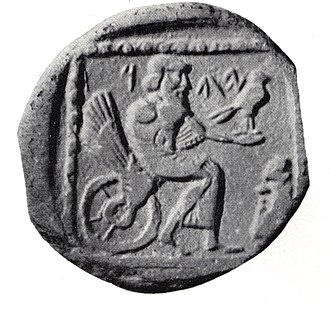Ātman (/ˈɑːtmən/; Sanskrit: आत्मन्) is a Sanskrit word that refers to the (universal) Self or self-existent essence of individuals, as distinct from ego (Ahamkara), mind (Citta) and embodied existence (Prakṛti).[note 1] The term is often translated as soul,[note 2] but is better translated as “Self,”[1] as it solely refers to pure consciousness or witness-consciousness, beyond identification with phenomena. In order to attain moksha (liberation), a human being must acquire self-knowledge (Atma Gyaan or Brahmajnana).
Atman is a central concept in the various schools of Indian philosophy, which have different views on the relation between Atman, individual Self (Jīvātman), supreme Self (Paramātmā) and, the Ultimate Reality (Brahman), stating that they are: completely identical (Advaita, Non-Dualist),[2][3] completely different (Dvaita, Dualist), or simultaneously non-different and different (Bhedabheda, Non-Dualist + Dualist).[4]
The six orthodox schools of Hinduism believe that there is Ātman in every living being (jiva), which is distinct from the body-mind complex. This is a major point of difference with the Buddhist doctrine of Anatta, which holds that in essence there is no unchanging essence or Self to be found in the empirical constituents of a living being,[note 3] staying silent on what it is that is liberated.
Yahweh[a] was the national god of ancient Israel and Judah.[3] The origins of his worship reach at least to the early Iron Age, and likely to the Late Bronze Age if not somewhat earlier.[4] In the oldest biblical literature he possesses attributes typically ascribed to weather and war deities, fructifying the land and leading the heavenly army against Israel’s enemies.[5] Most scholars are of the view that at that time the Israelites were polytheistic and worshipped him alongside a variety of Canaanite gods and goddesses, including El, Asherah and Baal.[6] In later centuries, El and Yahweh became conflated and El-linked epithets such as El Shaddai came to be applied to Yahweh alone,[7] and other gods and goddesses such as Baal and Asherah were absorbed into Yahwist religion.[8] According to other scholars, however, the exclusive worship of Yahweh was widespread before the Babylonian exile, and such Israelite monolatry may have even existed before the rise of the United Monarchy.[9][10] In Iron Age I, Yahweh’s cult center appears to have been Shiloh; by Iron Age II, it had been supplanted by Jerusalem, where the deity was enshrined in a Temple containing the Ark of the Covenant.[11]
Towards the end of the Babylonian captivity, the very existence of foreign gods was denied, and Yahweh was proclaimed as the creator of the cosmos and the one true God of all the world,[12] giving birth to Judaism, which has c. 14–15 million adherents today. During the Second Temple period, speaking the name of Yahweh in public became regarded as taboo,[13] and Jews instead began to substitute the name foremost with the word adonai (אֲדֹנָי, “my Lord”). In Roman times, following the Siege of Jerusalem and destruction of its Temple, in 70 CE, the original pronunciation of the god’s name was forgotten entirely.[14]
Yahweh is also invoked in Amherst Papyrus 63, and in Jewish or Jewish-influenced Greco-Egyptian magical texts from the 1st to 5th century CE.






